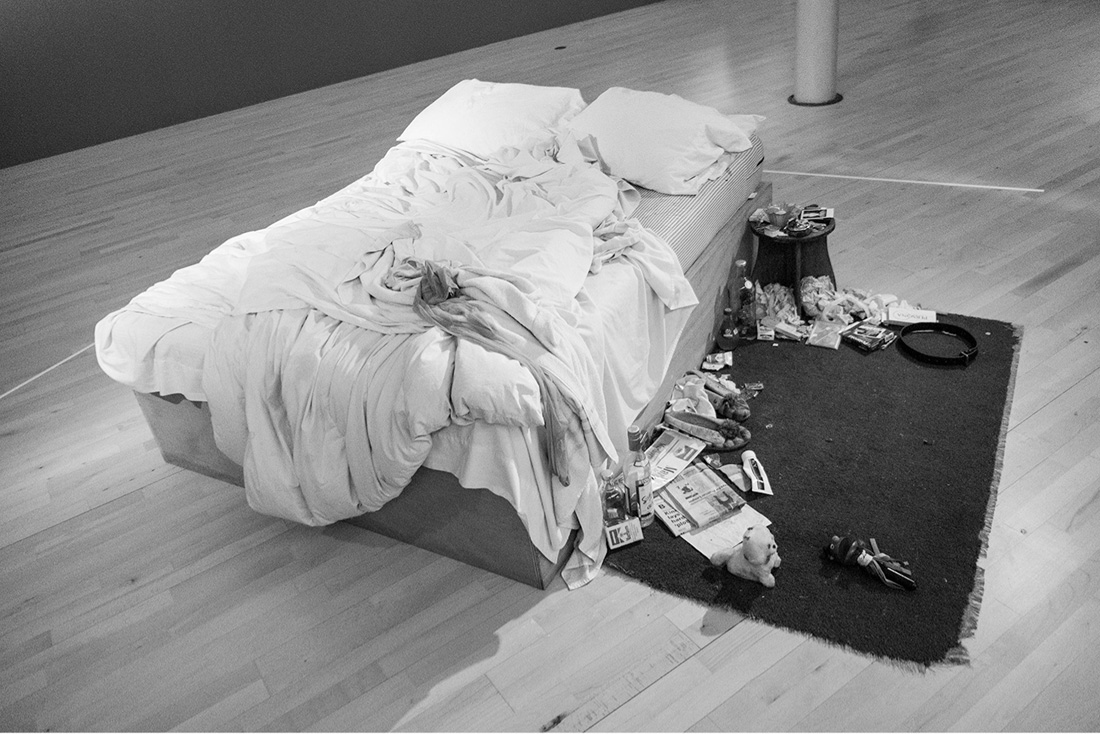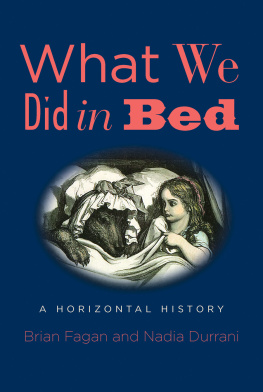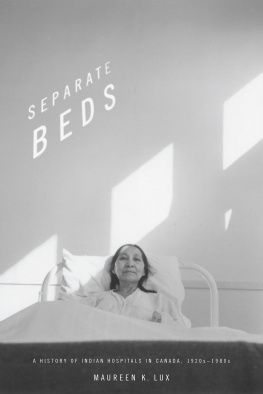What We Did in Bed

My Bed, Tracey Emin. Tate Modern, London, 1999.

Published with assistance from the foundation established in memory of Philip Hamilton McMillan of the Class of 1894, Yale College.
Copyright 2019 by Brian Fagan and Nadia Durrani.
All rights reserved.
This book may not be reproduced, in whole or in part, including illustrations, in any form (beyond that copying permitted by Sections 107 and 108 of the U.S. Copyright Law and except by reviewers for the public press), without written permission from the publishers.
Yale University Press books may be purchased in quantity for educational, business, or promotional use. For information, please e-mail (U.K. office).
Set in Janson type by IDS Infotech, Ltd.
Printed in the United States of America.
Library of Congress Control Number: 2019934208
ISBN 978-0-300-22388-0 (hardcover : alk. paper)
A catalogue record for this book is available from the British Library.
This paper meets the requirements of ANSI/NISO Z39.48-1992 (Permanence of Paper).
10 9 8 7 6 5 4 3 2 1
For Matt
Contents
Introduction
As Groucho Marx once joked, Anything that cant be done in bed isnt worth doing at all. He was probably right since humans, at one time or another, have done just about everything in bed. For the ancient Egyptians the bed was a vital link to the afterlife, in Shakespeares day it was a place for convivial socializing, and during the Second World War Winston Churchill ran Britain from within its sheets.
Today, however, the bed has been pushed into the shadows. Sleep therapists tell us it must be used only for sleep and sex. Perhaps because of its current status as private, most modern historians and archaeologists ignore the bed. Surprisingly little has been written about its history or the many roles it played in our lives. Yet the bed, where we still spend about a third of our lives, has big stories to tell. What our forebears did in bed covered everything from conception to death, with much in between. Given the boundless possibilities of writing such a book, we decided to arrange our beds into a series of themes, choosing the best bedtime stories to tell a new, horizontal history of what we did there.
Sex, birth, death, dining, ruling, plotting, dreading, dreaming: the theater of the bedchamber has provided rich inspiration for artists. In medieval Europe a recurring Christian motif was of the three wise men, apparently resting naked together in a bed, being blessed with divine revelation. Many eighteenth-century gentlemen artists preferred to turn their gaze to naked women languidly lying among confused sheets, perhaps helpless in the face of ravishment by enemies or exotic beasts, like the maiden in Henry Fuselis The Nightmare (1781). When the French artist Jacques-Louis David painted the deathbed scene of Socrates in 1787, he depicted the seventy-year-old philosopher as vibrantly alive and muscle-ripped: the embodiment of principled resistance to unjust authority on the eve of the French Revolution. Then there were images of unoccupied wooden beds, such as Van Goghs disarming blood-red bed in The Bedroom (1888) and Robert Rauschenbergs Bed (1955), its sleeping quilt painted with fingernail polish, toothpaste, and paint. More recently, the installation artist Chiharu Shiota has produced intricate, almost otherworldly bed-themed images such as During Sleep (2002), which shows women in white nightdresses asleep in hospital beds, weaving together ideas of female disease, weakness, and mythology.
Perhaps the most famous bed image of all is My Bed (1998) by the British artist Tracey Emin. In a moment of inspiration Emin displayed her post-breakup bed in all its crumpled disorder, surrounded by underwear stained by menstrual blood, empty bottles, cigarette butts, and used condoms. My Bed sparked a great deal of vitriolnot just because people questioned whether it was really art, but precisely because the bed today is considered a deeply private place that should not be discussed or seen in polite society. Yet such a viewpoint is very recent. In the early modern era, which the historian Carole Shammas has jokingly dubbed the Age of the Bed, the bed was often displayed in the main room for all to see, the most prized and valuable piece of furniture a family might buy. But our obsession with beds goes back much further.
Of our very earliest ancestors beds we have no evidence. They lived in predator-rich environments in the African heartland, at first sleeping in trees and then, as time unfolded, in rock shelters and caves as well as open camps, huddled close together before bright hearths. But how could they protect themselves against lurking beasts at night? Once tamed, fire offered not only warmth and cooked food but also protected places where people could gather and sleep after dark. It gave light and reassurance in the darkness of primordial landscapes where large animals hunted at night. We can imagine a hunting band sitting around a blazing hearth, the flames flickering in the darkness. Sometimes animal eyes would shine briefly in the gloom as beasts sought prey or discarded bones cast far from the flames. When darkness fell, human life revolved around the hearth and the rock shelter.
The oldest known beds come from a cave in South Africa. Dug into the cave floor, they were left by modern humans around seventy thousand years ago. It happens that the Proto-Germanic root of the word bed means a resting place dug into the earth. This is rather apt, not just because of the dug-out nature of the first beds but also because the bed has always been a place to rest, even though it was used for much more.
In modernitys well-heated houses we forget our ancestors vulnerability to nature and the environment, but how and where one slept was always crucial for both warmth and protection. In subzero climates like those of the Late Ice Age or of the Canadian Arctic as recently as two centuries ago, people would retire to bed as the temperatures plummeted and the days grew short, virtually hibernating under piles of furs. Sleepers living in winter houses on Independence Sound in Baffinland four thousand years ago spent the months of darkness in a semi-somnolent state, lying huddled together under thick, warm musk ox hides with food and fuel within easy reach.
Millions of people today still sleep on the ground or on concrete or wooden floors, wrapped in blankets or furs or swathed in clothing. But with the rise of civilization over five thousand years ago, beds often rose tooparticularly among the elite. In ancient Egypt the dry climate has preserved examples of such couches. By Tutankhamuns time, around the mid-fourteenth century BC, the basic design of the bed (as we would recognize it) was well established, albeit slightly higher at the pillow end and with a footboard to prevent the sleeper from sliding off. There might seem to be few variations on the theme of a sleeping platform, but as we dig deeper we find more. There were cupboard beds and hammocks, low waterbeds and high beds sixteen feet off the floor. Nonetheless, the basic rectangular design has changed remarkably little over the past five thousand years. Even mattresses have hardly changed over the millennia. Grass, hay, and straw stuffed into sacks or cloth bags served as the basic mattress for centuries. Those who could afford it slept on multiple layers to avoid the bugs and scratchiness of the stuffing. The great elaboration of sleeping technology is a product of the current century, with tricks and quackery to combat insomnia.
Next page











